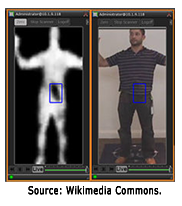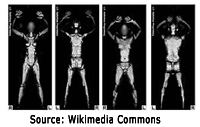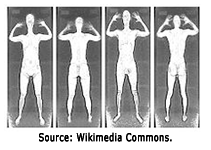Introduction
The recent deployment of full-body scanners in US airports, to scan airline passengers as part of the pre-flight security protocol, has generated more than a little controversy, with accusations of violation of privacy and health risks emanating from those opposed to the deployment, while those supporting the deployment issued statements to the effect that the technologies are safe and the benefits of deploying the technologies far outweighed the risks.
This brief looks at the dominant technologies in full-body scanning and examines the concerns associated with this security procedure, from an Indian perspective.
Full-Body Scanners
Full-body scanners are very effective in detecting objects concealed under a person’s clothing, without having the target remove his/her clothing or without physical contact. The procedure is faster – over in 15 seconds – than frisking, and avoids the intrusive aspect of frisking that some people find degrading.
There are two technologies that are primarily used, when it comes to full-body scanners: Millimeter Wave Scanner (Passive and Active) and Backscatter X-ray Scanner.
Millimeter Wave Scanner (Passive) Millimeter wave scanner technology is based on the principle that clothing is translucent in some EHF (Extremely High Frequency: 30 – 300 GHz) RF bands. Millimeter wave scanner technology is based on the principle that clothing is translucent in some EHF (Extremely High Frequency: 30 – 300 GHz) RF bands.Passive Millimeter Wave technology uses scanners that read the raw energy that is naturally emitted by the human body and by objects carried on the human body. The scanner generates a facsimile of the target based on the interpretation of these energies.The main advantage of Passive Millimeter Wave Scanner technology is that it is very safe for both the screener and the target, since there is no artificially generated energy directed at the target. As a consequence of the fact that the scanner relies on natural energy radiation, the resolution of the image generated by the scanner is not very high, which is a drawback; which in turn means that anatomical details of the target are indistinguishable, which is a plus with privacy advocates. |
|
Millimeter Wave Scanner (Active) The difference between Active Millimeter Wave Scanner technology and Passive Millimeter Wave Scanner technology is that active scanners direct millimeter energy at the target and then interpret the reflected energy. The millimeter wave is transmitted from two antennas simultaneously, as they rotate around the body. The wave energy reflected back from the body or other objects on the body is used to construct a three-dimensional image, which is displayed on a remote monitor for analysis.The advantage with Active Millimeter Wave Scanner technology is that the resolution of the scanned image is much higher than that of Passive Millimeter Wave Scanner technology. This automatically raises the hackles of privacy advocates, who object to the fact that it is a virtual strip-search and that scanned images may be at risk of misuse and abuse. Active Millimeter Wave Scanner technology does not raise serious concerns about the health of the target and screener, unlike Backscatter X-ray. The difference between Active Millimeter Wave Scanner technology and Passive Millimeter Wave Scanner technology is that active scanners direct millimeter energy at the target and then interpret the reflected energy. The millimeter wave is transmitted from two antennas simultaneously, as they rotate around the body. The wave energy reflected back from the body or other objects on the body is used to construct a three-dimensional image, which is displayed on a remote monitor for analysis.The advantage with Active Millimeter Wave Scanner technology is that the resolution of the scanned image is much higher than that of Passive Millimeter Wave Scanner technology. This automatically raises the hackles of privacy advocates, who object to the fact that it is a virtual strip-search and that scanned images may be at risk of misuse and abuse. Active Millimeter Wave Scanner technology does not raise serious concerns about the health of the target and screener, unlike Backscatter X-ray. |
|
Backscatter X-ray Scanner Backscatter X-ray is a significant variation of the traditional X-ray technology that is ubiquitous in the medical industry. In the traditional X-ray machine, high-energy X-rays are targeted at the patient, and these then pass through the targeted part of the patient’s anatomy to form an impression on a film on the other side. In Backscatter X-ray, low-energy X-rays are directed at the target. These X-rays are almost all absorbed within the first millimeters of the targets surface. Some of the absorbed X-rays generate a stream of low-energy photons back towards the scanner, which then creates an image of the target.The problem with all X-ray technology is that the energy is ionizing radiation which is known to cause damage to DNA, and is a known cancer risk. Proponents of Backscatter X-ray Scanner technology say that the energy of the X-rays used in such scanners is so low (lower than that air-travelers are subject to during a typical flight) that the risks of the technology are trivial compared to its benefits. However, there is no consensus among health experts about the non-toxicity of Backscatter X-ray technology. Privacy advocates have a problem with the technology, on account of the detailed nature of the images rendered. Backscatter X-ray is a significant variation of the traditional X-ray technology that is ubiquitous in the medical industry. In the traditional X-ray machine, high-energy X-rays are targeted at the patient, and these then pass through the targeted part of the patient’s anatomy to form an impression on a film on the other side. In Backscatter X-ray, low-energy X-rays are directed at the target. These X-rays are almost all absorbed within the first millimeters of the targets surface. Some of the absorbed X-rays generate a stream of low-energy photons back towards the scanner, which then creates an image of the target.The problem with all X-ray technology is that the energy is ionizing radiation which is known to cause damage to DNA, and is a known cancer risk. Proponents of Backscatter X-ray Scanner technology say that the energy of the X-rays used in such scanners is so low (lower than that air-travelers are subject to during a typical flight) that the risks of the technology are trivial compared to its benefits. However, there is no consensus among health experts about the non-toxicity of Backscatter X-ray technology. Privacy advocates have a problem with the technology, on account of the detailed nature of the images rendered. |
Applications in India
Full-body scanners are yet to find wide acceptance in India, mainly on account of the cost of the technologies. However, it is only a matter of time before they do make their appearance: either on account of the criticality of securing a location overriding the high cost of employing such technologies, or on account of other countries (notably the USA) forcing the Indian Government to apply full-body scanning procedures to travellers heading to those countries.
The concern in India is that, given the lack of importance given to privacy and to securing private data, procedures such as full-body scanning will generate a deluge of data that will not be properly secured; thereby leaving targets vulnerable to malafide actions and intentions. In the USA and Europe there are evolving SOPs with respect to maintaining the privacy of the target, while a full-body scan takes place, and ensuring that captured data is transient, if not deemed evidential. It will be highly desirable for the Indian Government to first define processes and systems that pick and choose the toughest norms (in the areas of target privacy and data security) listed in the above SOPs, and then approve the use of full-body scanning devices.
Conclusion
It is only a matter of time before the furore surrounding the deployment of full-body scanning technologies reaches Indian shores, and becomes a personal issue for many citizens. Law-enforcement agencies looking to deploy such technologies, as part of their homeland security architecture, should consult academia – both medical and legal – before deployment; with the objective of laying down privacy-tight and data-tight norms for dealing with the images generated by devices using these technologies.
Mistral Solutions’ C4ISR solutions and its MC3S (Mobile Command, Control, & Communications System) solution can integrate third-party full-body scanners, and serve as the back-end C&C engine for these systems.



